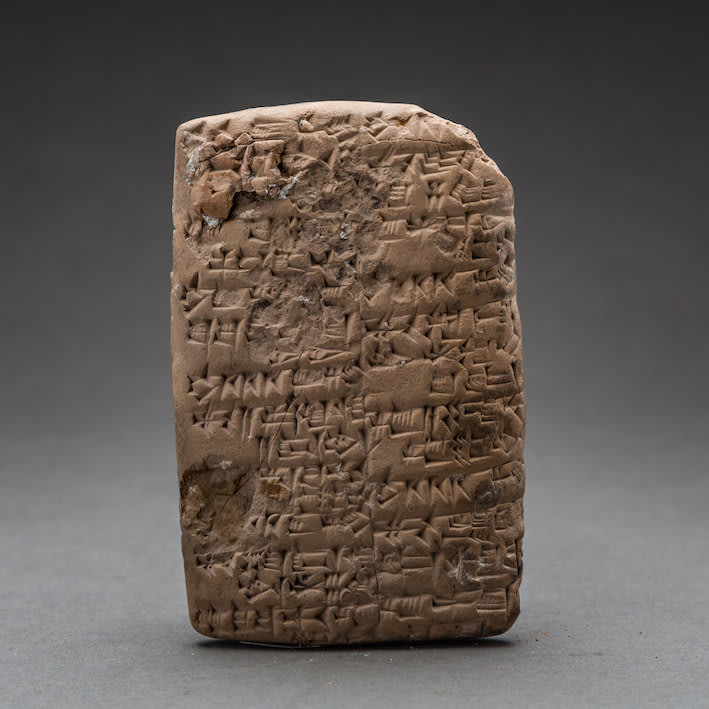Sumerian Cuneiform Tablet, 2030 BCE
Terracotta
2.75 x 4.25
LSO.603
Sumerian cuneiform is one of the earliest known forms of written expression. First appearing in the 4th millennium BC in what is now Iraq, it was dubbed cuneiform (‘wedge-shaped’) because...
Sumerian cuneiform is one of the earliest known forms of written expression. First appearing in the 4th millennium BC in what is now Iraq, it was dubbed cuneiform (‘wedge-shaped’) because of the distinctive wedge form of the letters, created by pressing a reed stylus into wet clay. Early Sumerian writings were essentially pictograms, which became simplified in the early and mid 3rd millennium BC to a series of strokes, along with a commensurate reduction in the number of discrete signs used (from c.1500 to 600). The script system had a very long life, and was used by the Sumerians as well as numerous later groups – notably the Assyrians, Elamites, Akkadians and Hittites – for around three thousand years. Certain signs and phonetic standards live on in modern languages of the Middle and Far East, but the writing system is essentially extinct. It was therefore cause for great excitement when the ‘code’ of ancient cuneiform was cracked by a group of English, French and German Assyriologists and philologists in the mid 19th century AD. This opened up a vital source of information about these ancient groups that could not have been obtained in any other way. Cuneiform was used on monuments dedicated to heroic – and usually royal – individuals, but perhaps it’s most important function was that of record keeping. The palace-based society at Ur and other large urban centres was accompanied by a remarkably complex and multifaceted bureaucracy, which was run by professional administrators and a priestly class, all of whom were answerable to central court control. Most of what we know about the way the culture was run and administered comes from cuneiform tablets, which record the everyday running of the temple and palace complexes in minute detail, as in the present case. The Barakat Gallery has secured the services of Professor Lambert (University of Birmingham), a renowned expert in decipherment and translation of cuneiform, to examine and process the information on these tablets. His analysis is presented below. Clay Tablet (103 x 67 mm) with 52 lines of Sumerian Cuneifor The obverse and reverse are both divided into two columns, and those on the obverse are full, those on the reverse have gaps in the writing. There is some damage to the writing, and the upper right hand corner is also damaged, but most of the script remains and can be read. It is an administrative document from the period of the Third Dynasty of Ur, dated to the 4th year of Shu-Sin, fourth king of the dynasty, c. 2034 BC. It is a list of consignments of bundles of reeds with total at the end. Translation: 7,200 bundles of reeds,……document of Baz …foreman of the craftsme 3,600 bundles of reeds, document of Zuzu, son of ……-il 5,400 bundles of reeds, with reference to Atala and Adallal, document of Tarabati…
scribe of 10 oxe 5,400 bundles of reeds, with reference to Tuda and Warad-Ashgi, document of Kubati, scribe of 10 oxe 5,400 bundles of reeds, with reference to Iddin-…, and Sallum, document of Ilum-bani, scribe of 10 oxe 1,800 bundles of reeds, with reference to Elme and Lu-Ningirsu, document of Abushunu, scribe of 10 oxe 1,800 (bundles of) reeds, with reference to Enlil-…ka and Zuzu, document of Qassu and Sus 5,400 bundles of reeds, with reference to Ashgi-illassu and Titi, document of Inassis-awilum and Puzur-Haya. Total 43,200 bundles of reeds, put to the account of …… received from Ishtar-alshu, document of …… via Tuda. *** Reeds were an important item in Sumerian civilization: they served to make houses, boats, mats, reinforcement for big brick structures and other things, including styluses for scribes to write with. They grew in the marshes freely, often to a height of 20 feet and needed no cultivation. This document is characteristic for their gathering, and the summary at the end seems to be wrong arithmetic. There may be an explanation, but slight damage to some of the signs may explain it. (NB the actual total of these figures is 36,000).
scribe of 10 oxe 5,400 bundles of reeds, with reference to Tuda and Warad-Ashgi, document of Kubati, scribe of 10 oxe 5,400 bundles of reeds, with reference to Iddin-…, and Sallum, document of Ilum-bani, scribe of 10 oxe 1,800 bundles of reeds, with reference to Elme and Lu-Ningirsu, document of Abushunu, scribe of 10 oxe 1,800 (bundles of) reeds, with reference to Enlil-…ka and Zuzu, document of Qassu and Sus 5,400 bundles of reeds, with reference to Ashgi-illassu and Titi, document of Inassis-awilum and Puzur-Haya. Total 43,200 bundles of reeds, put to the account of …… received from Ishtar-alshu, document of …… via Tuda. *** Reeds were an important item in Sumerian civilization: they served to make houses, boats, mats, reinforcement for big brick structures and other things, including styluses for scribes to write with. They grew in the marshes freely, often to a height of 20 feet and needed no cultivation. This document is characteristic for their gathering, and the summary at the end seems to be wrong arithmetic. There may be an explanation, but slight damage to some of the signs may explain it. (NB the actual total of these figures is 36,000).



